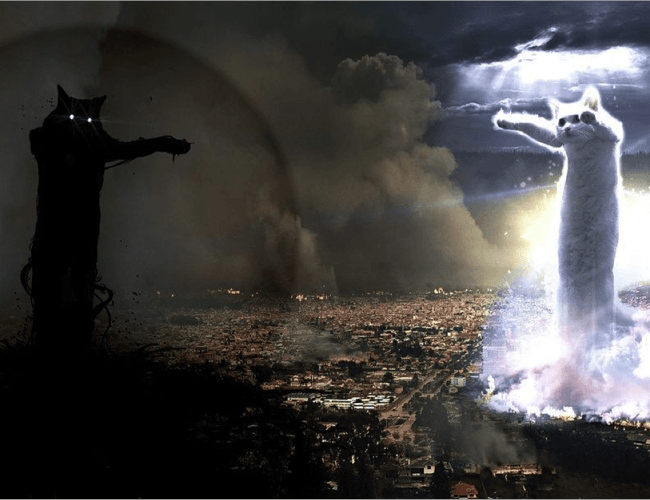SUPERCONVERSATIONS DAY 71: JESSIE BEIER RESPONDS TO TOM HOLERT, “BLACKOUT CITY”
#Reflections In/On The Dark
Image Source.
But as the lights went off in Paris, as this “skeleton of blackness” (Tom Holert, “Blackout City”) embraced those witnessing the Eiffel Tower’s deliberate blackout, another set of lights continued to flicker in homes and offices around the world. Armed with hashtags, political cartoons and jaunty gif-animated images, THE INTERNET continued its eruption of Je Suis Charlies and unfettered opinions, further solidifying online identities across the globe. Who’s side are you on, anyways? Light or dark? The writing on the wall, so to speak, collected into pools of politicized feelings; posting, sharing, and liking operated as the modes with which we marked authentic identities, which could then be categorized, aestheticized, and, like the light of the tower itself, worshipped.
And likewise, just the other day, after the killing of one now famous lion, the Empire State Building projected images of endangered species more than 350 feet tall and 180 feet wide in an “effort to spark conversations about mass extinction”. This time, however, the gesture was one of illumination. Once again, as this spectacular call to action animated the New York skyline, THE INTERNET reacted with overzealous disgust for the actions of one Minnesotan dentist, while fervently arguing how the death of a singular animal in Africa measures up to the lives lost on American soil daily. Who’s side are you on, anyways? Light or dark?
The ‘fight’ between light and dark seemingly carries on, even with the understanding that these two concepts, infinitely differentiating in their potential, escape simply binary logic. Like the ‘black holes’ of the face, which exist as the necessary co-requisite of the flat ‘white surface’, or wall of the signifier, light and dark cannot exist without one another. As Deleuze and Guattari (1987) write, the face, much like our cosmos, is from the beginning a horror story, but is nevertheless territorialized and indexed through all-too-human regimes of representation and identification3. Black holes become eyes, ears, and mouths, formed against an idealized “human” face, in turn overcoding the subject through the implicit idea that particular identifications are able to coexist within an environment where dominant identifications determine the field. And thus, the “human” face, imposed on us universally, is that which constantly over-determines our identities. At the same time, it is this “human” face, one created through the division, categorization, and dissension of dark and light that allows us to, yes, face the world. As Holert points out, however, the “profoundly non-digital, non-computable” character of light and dark escapes any 1/0 logic. Like the face, these concepts do not come ready-made. Nevertheless, for the time being the dichotomy of light and dark “has proven to be rather unavoidable, if not to say a necessary prism to better apprehend the peculiar entanglement of politics, physics, economics, ecology and religion in the present moment”.
What was it that Rust Cohle said again? “It’s just one story. The oldest. […] Light versus dark”.
Image Source.
And according to everyone’s favourite fictional pessimist, “the light seems to be winning”.
As Holert highlights in “Blackout City”, however, this might not be the case. In a consideration of the growing gestures of collective grievance and resilience born in response to the challenges facing the Western world, Holert points to the potential for various modes of darkening to act as new forms of resistance. Holert acknowledges the symbolic, economical, public relational, and ecological uses of darkness at the level of city infrastructure, with a brief nod to the “upsurge in thinking around notions of darkness and blackness”1 at the level of thought itself. While darkness is employed strategically (if paradoxically) in service of municipal, national, or Western interests, a similar darkness is creeping into the realm of knowledge production, in turn impacting our own resources for thinking. Holert cites, among others, Negarestani’s speculations on Ahkt, the fallen black sun god of oil, and Thacker’s cosmic pessimism (see also Eugene Thacker, “Darklife: Negation, Nothingness, and the Will-to-Life in Schopenhauer,” Parrhesia, No. 12, 2011, 12-27 & Starry Speculative Corpse: Horror of Philosophy, 2015). Elsewhere, a Dark Deleuze rears its head, favouring destruction over creation, cruelty over intensity, and interruption over production, while a Dark Mountain forms, bringing with it new principles of uncivilisation. As Holert asserts, acknowledging darkness itself, even in its most unimaginable and unknowable forms, has gained appeal, providing new trajectories to think in/of the world.
Steve Jobs, Satya Nadalla (Credit: AP/Paul Sakuma/Brendan McDermid/rnl, Kaveryn Kiryl via Shutterstock/Salon).
There is, perhaps, good reason for this turn to darkness. This retreat into the shadows offers a much-needed alternative to the ubiquitous and unfettered propagation of a certain Faux Enlightenment (“Mindfulness is a capitalist grift: How faux enlightenment maintains our status quo”) , a perpetual dream of transcendence, that continues to mark our collective drive for low-level happiness. The sense of hope this enlightenment provides, this “inconsistent joy” (as Spinoza posits), helps us cover over the void of an otherwise meaningless existence, in turn maintaining the status quo. In place of those grand enlightenment thinkers of the 17th and 18th centuries, we now have a slough of public figures, your Oprah Winfreys, your Steve Jobs, and your Phil Jacksons to name a few, after whom we can model our dreams of a more enlightened, and thus happy, existence. Big Business, has also been blinded by the light, employing so-called enlightenment strategies from mindfulness to positive thinking, in order to actualize the most efficient and productive workers possible. At the level of personal interactions, I have also witnessed an ongoing parade of techniques of radical self-love, which in my mind only work to further perpetuate the idea that happiness can (and must) be attained through individualistic, narcissistic, all-too-human prioritizations.
Of course, this search for light might seem like a ‘natural response’ to life’s persistent darkness: feelings of despair, anxiety and utter futility, produced and maintained by contemporary capitalism and increasingly dispersive systems of control, have rendered us feeling alone and compliant. But this is only because these feelings are modulated by moments of hope, an illusory light at the end of the tunnel. And thus, dark thinking provides a welcome response to the moral imperative for happiness, which has come to be conflated with images of transparency, accountability, light, Truth. Call it what you will: a misanthropic subversion, a realist pessimism, a new form of anti-political resistance, a return to Bartleybism, a post-nihilist gesture. Dark times are calling forth dark measures, bringing with them new impetus for political, social, and artistic resistances.
In my own field, the decidedly optimistic field of education, these dark trajectories have provided both new problems and new horizons to deal with what I see as a certain ‘stuckness’ within pedagogical thought. In the name of past habits and future hopes, even so-called progressive pedagogies struggle to hold the line, keeping ordinary (and often unproductive) routines locked in place. The Western educational project, one founded and reliant still on Enlightenment principles, is driven by a deep-seated optimism that works to perpetually repeat and amplify what has been recognized as ’good’ in the past. The problem for contemporary pedagogy is thus how to deal with the expectation that education should provide hope, given the challenges of contemporary times. At the same time that growing job precarity, ever-increasing focus on quantity over quality, and the slippery corporatization of educational domains weigh on education scholars (not to mention students), there remains a pressure to position education as that holy space where hope is born and light prevails. This comforting narrative, however, does not adequately address the real, material conditions of our contemporary existence, raising the important question: If every decision to teach/learn involves some sort of commitment to the/a future (I would argue it does), how does one go on teaching in and about dark times?
As a beginning response, the face of education, one subtended by notions of light, hope, optimism, and an essential human exceptionalism, must be dismantled in order to reveal the horrific susceptibility of this identitarian and universalizing constraint to new planes of potential. Once again, and as Deleuze and Guattari assert, the face is, at the beginning, a horror story. It is perhaps through this dismantling gesture, through self-annihilation, or what Holert acknowledges as a voluntary concession, a performance of self-injury, that “various modalities of darkness should be renegotiated with an eye for those common futures when light will not only have become scarce or dangerous, but simply less desirable” (Tom Holert, “Blackout City”).
Jessie Beier is an artist, writer and independent scholar who currently teaches in the area of pedagogy and curriculum studies at the University of Alberta in Edmonton, Alberta, Canada.


